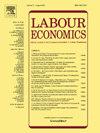Health workforce reallocation in the aftermath of conflict: Evidence from Colombia
IF 2.6
2区 经济学
Q2 ECONOMICS
引用次数: 0
Abstract
While a large literature has studied the effects of violent conflict on health outcomes, little is known about how violence reduction can affect a key driver of post-conflict recovery, namely the quantity and type of healthcare workers. By leveraging a permanent ceasefire that ended over five decades of armed conflict between the Colombian government and the FARC insurgency, we study the extent to which conflict termination affected the share of different types of health workers in areas more exposed to FARC violence relative to other places. Based on administrative records on the location of all formal healthcare workers in Colombia and using a difference-in-differences strategy, we find that a municipality that experienced one standard deviation higher FARC violence intensity relative to the rest of the country witnessed 13.4% post-ceasefire differential decrease in the share of employed healthcare workers per 1,000 people. We find a stronger decrease among vocational nurses and a weaker decrease among physicians. We show that this effect is likely explained by lifting mobility restrictions in previously violent areas, and document that, because the net reduction in healthcare workers increased the within-municipality share of (higher-educated) physicians, it did not translate into a deterioration of mortality rates or healthcare service provision.
冲突后卫生人力的重新分配:来自哥伦比亚的证据
虽然大量文献研究了暴力冲突对健康结果的影响,但对于减少暴力如何影响冲突后恢复的一个关键驱动因素,即卫生保健工作者的数量和类型,知之甚少。通过利用哥伦比亚政府与哥伦比亚革命武装力量(FARC)叛乱分子之间长达50多年的武装冲突的永久停火,我们研究了冲突终止对相对于其他地方更容易遭受哥伦比亚革命武装力量暴力的地区不同类型卫生工作者比例的影响程度。根据哥伦比亚所有正规卫生保健工作者所在地的行政记录,并采用差异中的差异策略,我们发现,与该国其他地区相比,FARC暴力强度高出一个标准差的城市,每1,000人雇用卫生保健工作者的比例在停火后差异减少13.4%。我们发现职业护士的下降幅度更大,而医生的下降幅度较小。我们表明,这种影响可能是通过解除以前暴力地区的流动限制来解释的,并证明,因为医疗工作者的净减少增加了城市内(受过高等教育的)医生的份额,它并没有转化为死亡率或医疗服务提供的恶化。
本文章由计算机程序翻译,如有差异,请以英文原文为准。
求助全文
约1分钟内获得全文
求助全文
来源期刊

Labour Economics
ECONOMICS-
CiteScore
3.60
自引率
8.30%
发文量
142
期刊介绍:
Labour Economics is devoted to publishing research in the field of labour economics both on the microeconomic and on the macroeconomic level, in a balanced mix of theory, empirical testing and policy applications. It gives due recognition to analysis and explanation of institutional arrangements of national labour markets and the impact of these institutions on labour market outcomes.
 求助内容:
求助内容: 应助结果提醒方式:
应助结果提醒方式:


